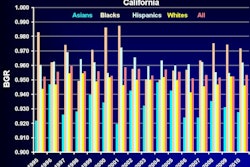Attacking imaging overutilization through blanket reductions in reimbursement could have unintended consequences, according to a new study published in this month's Health Affairs. Such cuts could backfire by also reducing imaging for patients who need it.
Researchers from New York University School of Medicine examined the appropriateness of imaging received by prostate cancer patients between 2004 and 2005. They found that geographic regions with lower rates of inappropriate imaging also had lower rates of appropriate imaging. Regions with higher overall imaging rates tended to have not only higher rates of inappropriate imaging, but also higher rates of appropriate imaging. In fact, men with high-risk prostate cancer were more likely to receive appropriate imaging if they lived in areas with higher rates of inappropriate imaging (Health Affairs, April 2012, Vol. 31:4, pp. 1-11).
Lead author Dr. Danil Makarov, a urologist, and colleagues described this finding as the "thermostat model": Each region tends to use healthcare resources in ways that affect both appropriate and inappropriate use, and lower-use regions may not necessarily be using resources for appropriate care.
"We're in the middle of a huge healthcare debate, where government, hospitals, and physician groups are working to lower healthcare costs while still providing quality care," Makarov told AuntMinnie.com. "One area being reviewed is imaging use. Changing practices in regions of high use to make them more like those in areas of low use to lower costs may seem like an appealing strategy. However, our study suggests that such an approach might sacrifice quality by depriving patients of needed services."
A symbiotic relationship?
In the study, Makarov's team used a sample of 48,148 prostate cancer patients between the ages of 66 and 85. The men were diagnosed with cancer between 2004 and 2005. The researchers used this cohort to examine whether appropriate and inappropriate imaging levels were associated with overall regional imaging frequency, and whether, at the regional level, appropriate imaging among men with high-risk prostate cancer was associated with inappropriate imaging among those with low-risk disease. Data came from the Surveillance, Epidemiology, and End Results (SEER) Medicare-linked database and included 16 regions.
"Prostate cancer is an ideal test case for several reasons," Makarov's group wrote. "First, diagnostic imaging is an expensive, increasingly used modality, and prostate cancer is a common disease. Second, clinical guidelines suggest which patients should and should not receive imaging, providing a clear and widely disseminated definition of 'appropriate' and 'inappropriate' use. Finally, large, nationally representative datasets document the degree to which these criteria are applied in clinical practice."
The team used 2002 guidelines of the National Comprehensive Cancer Network to define high risk. It was considered appropriate for patients in the high-risk group to have a bone scan if they had any one of the following conditions: clinical stage of at least T3, a Gleason score greater than seven, prostate-specific antigen greater than 10 ng/mL, or symptoms that suggest advanced disease, such as bone pain. Patients were defined as low risk if they did not meet these criteria, and among low risk patients, any imaging study was considered inappropriate (unless patients were undergoing external beam radiation therapy, in which case CT for planning purposes was considered appropriate), the authors wrote.
Makarov and colleagues identified 18,491 men with low-risk prostate cancer and 10,562 men with high-risk disease. The rates of inappropriate imaging among men with low-risk prostate cancer (unadjusted for Gleason grade, antigen level, clinical stage, education, race, comorbidity, age, and income) ranged from a high of 65% in New Jersey to a low of 24% in Utah. Unadjusted rates of appropriate imaging for men with high-risk prostate cancer varied from a low of 50% in Atlanta to a high of 79% in Utah.
Regions with high rates of appropriate imaging also had high rates of inappropriate imaging; therefore, policy measures aimed at simply curbing unnecessary imaging in regions with high imaging use could unintentionally decrease imaging services for those patients who really need them, the team wrote.
The bottom line is that cost-control policies must selectively educate providers to change their behavior and reduce the use of unnecessary care, while still ensuring appropriate care, according to Makarov's group. This could take many forms, including profiling physicians who inappropriately overuse resources, linking payment to appropriate utilization criteria, or providing rewards and incentives to physicians and organizations that optimize their resource use.
"New policies aimed at controlling costs cannot be a 'one-size-fits-all' approach," Makarov said. "Instead, policies must be multifaceted to carefully blend cutting inappropriate use while promoting appropriate use."




















